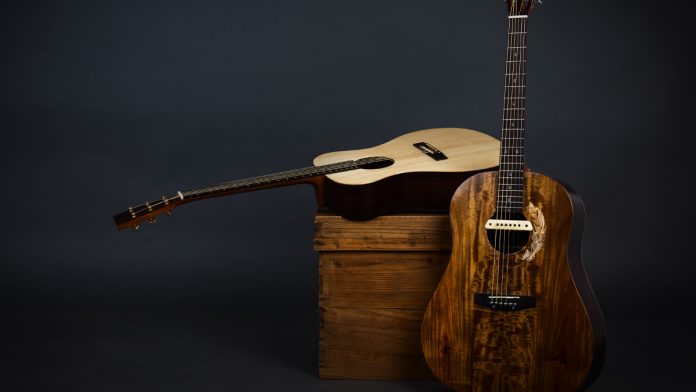Here we will delve into the Physics and Engineering Behind Acoustic Guitar by examining how physical forces, material properties, and precise engineering craft the expressive sound of this beloved instrument. By exploring the interplay between vibration, resonance, and innovative design, we reveal how fundamental concepts and advanced computational techniques have transformed the acoustic guitar in the modern musical industry.
| Table of Contents | |
|---|---|
| I. | Vibration Fundamentals and String Dynamics |
| II. | Energy Transfer from Strings to Soundboard |
| III. | Soundboard Resonance and Modal Behavior |
| IV. | Helmholtz Resonance in the Body Cavity |
| V. | Acoustic Impedance Matching |
| VI. | Material Properties and Their Impact on Acoustics |
| VII. | Structural Engineering of Internal Bracing |
| VIII. | Bridge and Saddle Design Optimization |
| IX. | Nonlinear Dynamics and Damping Mechanisms |
| X. | Finite Element Modeling and Computational Acoustic Simulation |
| X. | Innovative Technologies in Acoustic Guitar Engineering |
Vibration Fundamentals and String Dynamics
The basis of any acoustic guitar’s sound lies in the vibration of its strings. Each plucked string initiates complex motions that embody the Physics Behind Acoustic Guitar through harmonic overtones and phase interactions. The string dynamics, influenced by tension, mass, and length, set the stage for a unique tonal quality essential to the musical instruments industry. This section emphasizes how understanding string vibration is crucial for both instrument makers and players seeking optimal performance and pitch clarity.
Energy Transfer from Strings to Soundboard
When a string vibrates, energy is efficiently transferred to the soundboard, amplifying and enriching the tone of the acoustic guitar. This process highlights the Engineering Behind Acoustic Guitar by focusing on how mechanical energy converts to acoustic energy, ensuring that subtle nuances reach the listener. Designers pay meticulous attention to the coupling between strings and soundboard, enhancing resonance while preserving the instrument’s dynamic range within the competitive musical instruments industry.
Soundboard Resonance and Modal Behavior
The soundboard of an acoustic guitar is engineered to resonate at specific frequencies, thereby accentuating the sound quality. This resonance and its modal behavior play a pivotal role in shaping the overall timbre. By fine-tuning these modes, manufacturers harness both the Physics Behind Acoustic Guitar and the artistic demands of players. The precise modal distribution ensures clarity, sustain, and a well-balanced sound, making it a critical focus in crafting high-quality guitars in the musical instruments industry.
Helmholtz Resonance in the Body Cavity
Central to an acoustic guitar’s deep, full-bodied sound is the Helmholtz resonance within its body cavity. This phenomenon, where the cavity air oscillates in tandem with the vibrating soundboard, enhances low-frequency response. Understanding and optimizing Helmholtz resonance demonstrate a sophisticated blend of Engineering Behind Acoustic Guitar with practical acoustic science. This carefully tuned resonance contributes to the instrument’s warm sound signature, reinforcing its status as an essential element in the musical instruments industry.
Acoustic Impedance Matching
Acoustic impedance matching is critical in ensuring that energy from the vibrating soundboard is efficiently transferred to the surrounding air. In acoustic guitars, the design is optimized to minimize energy losses and maintain tonal purity. This process marries theoretical insights with practical applications, aligning with both the Physics Behind Acoustic Guitar and modern acoustic design principles. By controlling impedance, manufacturers elevate the performance and expressiveness of these instruments in the competitive musical instruments industry.
Material Properties and Their Impact on Acoustics
The selection of tonewoods and composite materials significantly influences the tonal characteristics of an acoustic guitar. Material properties such as density, elasticity, and damping factor impact both the sound radiation and longevity of the instrument. This synergy between natural materials and engineered components is at the heart of the Engineering Behind Acoustic Guitar, ensuring that each instrument produces a distinct, resonant sound. In this way, material choices become a critical factor in the craftsmanship that defines the musical instruments industry.
Structural Engineering of Internal Bracing
Internal bracing systems within an acoustic guitar are meticulously designed to support the soundboard while allowing it to vibrate freely. The layout and construction of these braces affect not only the instrument’s durability but also its sound projection and tonal balance. Effective bracing contributes to the delicate equilibrium between rigidity and flexibility, ensuring optimal acoustic response. This intricate balance reflects advanced practices in the Engineering Behind Acoustic Guitar, underscoring the role of precise structural engineering in the evolution of high-performance musical instruments.
Bridge and Saddle Design Optimization
The bridge and saddle are critical interfaces for transferring string vibrations to the soundboard. Their design and material composition play an essential role in determining the clarity and richness of the acoustic guitar’s tone. Optimized bridge and saddle configurations ensure that maximum vibrational energy is delivered while minimizing unwanted damping. This attention to detail exemplifies the practical challenges of the “Engineering Behind Acoustic Guitar” and is essential for achieving high fidelity in sound reproduction, a crucial aspect in the musical instruments industry.
Nonlinear Dynamics and Damping Mechanisms
Nonlinear dynamics and damping mechanisms come into play in controlling the complex vibrational behavior of acoustic guitars. These processes help shape the instrument’s response to varying levels of input energy, allowing for nuanced expression and sustain. The careful management of nonlinearity and damping is key to refining tonal quality, as they influence both attack and decay characteristics. This aspect integrates sophisticated theories of the Physics Behind Acoustic Guitar with innovative design strategies aimed at delivering exceptional performance in the musical instruments industry.
Finite Element Modeling and Computational Acoustic Simulation
Finite element modeling and computational simulation have become invaluable tools in designing modern acoustic guitars. By predicting vibrational patterns and optimizing material distributions, these techniques enable manufacturers to experiment with new designs without costly prototypes. This approach merges the principles of both the Physics Behind Acoustic Guitar and the Engineering Behind Acoustic Guitar, offering precise insights into how each design change affects overall sound quality. Computational methods continue to revolutionize the design process, reinforcing the guitar’s role as a cutting-edge product in the musical instruments industry.
Innovative Technologies in Acoustic Guitar Engineering
Recent advancements, such as 3D printing, smart sensors, and novel composite materials, have opened new avenues in acoustic guitar innovation. These technologies enable a fusion of traditional craftsmanship with modern precision engineering. By integrating innovative technologies, manufacturers enhance the playability, durability, and tonal performance of acoustic guitars. This evolution represents a dynamic application of both the Physics Behind Acoustic Guitar and the Engineering Behind Acoustic Guitar, ensuring that every instrument meets the evolving demands of musicians and remains a standout product in the musical instruments industry.

